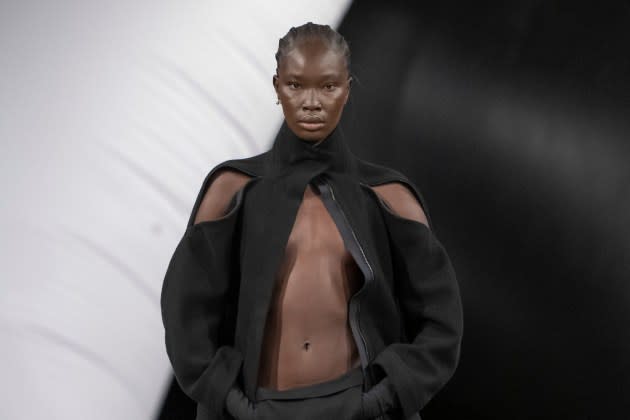How to Style Eastern Wear Pakistan Clothes for Contemporary Style
How to Style Eastern Wear Pakistan Clothes for Contemporary Style
Blog Article
Open the Secrets of Ageless Eastern Use
Checking out the enigmatic world of ageless Eastern wear looks into a realm where virtuosity, society, and history merge to create garments that transcend simple material and string. The complex tapestry of custom interwoven with contemporary aspects offers a glimpse into a world where every stitch tells a tale, every motif a sign of significance. Unveiling the keys behind these productions unveils a tapestry of heritage waiting to be unraveled, welcoming one to journey through the angelic beauty and aura of Eastern fashion.
Background of Eastern Style
The background of Eastern style go back centuries, mirroring the abundant social heritage and customs of diverse areas throughout Asia. Each region flaunts its special designs, fabrics, and styles that have actually been affected by elements like climate, faith, social status, and profession paths. eastern wear pakistan. As an example, the elaborate silk garments of China symbolize beauty and elegance, while the dynamic saris of India display a kaleidoscope of shades and patterns.
In Japan, the robe has been a symbol of practice and improvement for generations, with different styles used for various celebrations. The history of Eastern fashion is a tapestry of advancement and custom, blending old methods with modern-day impacts to create an ever-evolving and vibrant market.
Relevance of Traditional Clothing
Standard attire functions as a cultural emblem, symbolizing the values, ideas, and heritage of communities in Eastern cultures. eastern wear pakistan. These garments are not just items of fabric yet are symbolic representations of the rich background and practices gave via generations. In Eastern societies, conventional clothing plays a considerable role in events, events, and every day life, mirroring the social condition, local associations, and also marriage status of individuals
The importance of standard attire goes beyond aesthetics; it is a means for individuals to get in touch with their origins and reveal pride in their social identification. Each garment, from the intricate sarees of India to the streaming hanboks of Korea, brings with it a story of craftsmanship, meaning, and symbolism that is deeply deep-rooted in the fabric of society.
Furthermore, traditional clothing functions as an aesthetic language, communicating stories of resilience, victory, and unity. By putting on these garments, individuals not just recognize their heritage but also add to the conservation and event of their social legacy.
Evolution of Eastern Embroideries
Exactly how have Eastern embroideries evolved in time to mirror transforming creative trends and social impacts? Eastern embroideries have an abundant background that extends centuries and have actually constantly advanced to include diverse social impacts and react to moving creative trends. The evolution of Eastern needleworks can be mapped back to ancient civilizations where complex designs were hand-stitched onto textiles making use of standard strategies. Throughout the years, these needleworks have adapted to reflect the changing preferences and choices of different areas and ages.

Today, Eastern embroideries continue to evolve, blending conventional workmanship with modern-day layout perceptiveness to create classic pieces that commemorate the appeal of social variety and creative innovation.
Lavish Fabrics in Eastern Use
Lavish textiles play an essential function in elevating the visual allure and top quality of Eastern wear, enhancing the general attraction and refinement of traditional garments. Eastern wear is renowned for its extravagant fabrics that not just mirror the region's rich cultural heritage but also symbolize style and grace.
Along with silk, materials like velour, chiffon, and brocade are also commonly featured in Eastern wear. Velvet brings a royal and plush feeling to traditional sets, while brocade, with its metallic strings and complex patterns, adds a touch of splendour. Chiffon, on the other hand, is favored for its lightweight and airy qualities, making it a web popular option for flowing silhouettes and fragile decorations. These lavish materials not just boost the aesthetic allure of Eastern wear however additionally guarantee a sense of refinement and class that transcends time.
Incorporating Eastern Fashion Today
In contemporary official source fashion landscapes, the integration of Eastern influences offers a harmonious blend of cultural heritage and modern-day visual appeals. Designers and style fanatics alike are accepting the abundant tapestry of Eastern fashion, incorporating conventional elements into modern silhouettes and designs. From detailed embroidery to lively colors and extravagant fabrics, Eastern fashion today provides a varied variety of choices that deal with a worldwide audience.
One way Eastern fashion is making its mark in modern closets is with the adjustment of standard garments such as the kimono, saree, or qipao into everyday wear. These items, once reserved for unique occasions, are now reimagined in more informal forms, enabling their consolidation into day-to-day fashion selections. Additionally, the usage of conventional patterns and concepts in Western-style clothes includes a touch of exotic style to modern-day attire.

Final Thought
To conclude, discovering the rich history, relevance, and evolution of Eastern fashion introduces an ingrained link to heritage and values. The glamorous textiles and complex needleworks of Eastern use showcase the adaptability and eternity of traditional styles. Integrating Eastern affects in modern style enables for a fusion of practice and innovation, developing an unified balance in between the past and the here and now.
Glamorous textiles site here play an essential duty in elevating the aesthetic charm and high quality of Eastern wear, enhancing the general appeal and sophistication of standard garments. Designers and style enthusiasts alike are welcoming the abundant tapestry of Eastern fashion, incorporating typical components right into modern-day shapes and designs. From complex embroidery to vivid shades and glamorous textiles, Eastern fashion today offers a diverse array of alternatives that cater to a global audience.
One means Eastern style is making its mark in modern closets is via the adaptation of standard garments such as the bathrobe, saree, or qipao right into daily wear. The elegant materials and elaborate needleworks of Eastern wear showcase the versatility and eternity of standard layouts.
Report this page